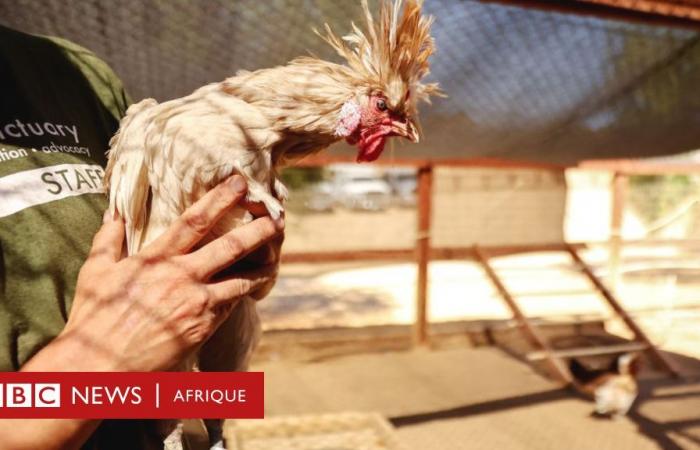11 minutes ago
Photo credit, Getty Images
Avian flu is spreading among cattle herds in the United States, a surprising development that worries scientists.
There is no evidence that the virus can cause an outbreak in humans, but authorities are closely monitoring the situation. What do we know about the H5N1 virus and how worried should we be? What is bird flu? Bird flu is an illness caused by a virus that infects birds and sometimes other animals, such as foxes, seals and otters. The main strain, which circulates among wild birds around the world, is a type of virus known as H5N1. It appeared in China in the late 1990s. Bird migration led to outbreaks among domestic and wild birds. In very rare cases the virus has infected humans. Scientists believe the current risk to humans is low. Transmission from birds to humans is rare and there has been no sustained human-to-human transmission. There is no way to predict whether bird flu will trigger a pandemic in humans, but experts monitor its spread and study its evolution.
Photo credit, Getty Images
The H5N1 virus is spreading rapidly among dairy cow herds in the United States, in what the U.S. Centers for Disease Control (CDC) describes as an “ongoing multistate outbreak.” The appearance of the virus in cattle stunned scientists, who thought cows were not susceptible. It comes against the backdrop of another unusual event: In early June, a 59-year-old man died in Mexico from another type of flu. avian, H5N2, which had never before been observed in humans. It is unclear how he contracted it, although cases have been observed on some poultry farms in Mexico. Health organizations such as the World Health Organization and the CDC consider the overall risk to public health linked to avian flu is low. But scientists say the spread of the virus needs to be closely monitored. “This case adds to a series of developments which collectively could be seen as a wake-up call,” says Professor Sir Peter Horby, director of the Institute of Pandemic Science at the University of Oxford. H5N1 has been in the crosshairs of scientists for several years, with the virus having spread to all continents. Thousands of outbreaks have been recorded in poultry and wild birds. Outbreaks have occurred in animals raised for their fur, including mink. At the end of 2023, in Peru, more than 5,000 sea lions died from the virus, which scientists believe was caused by the animals’ direct contact with infected wild birds. The virus has also been detected in foxes, bears, otters, raccoons, cats, dogs, goats and other animals. “It’s a virus that progresses, that’s why we’re monitoring it with concern,” says Dr Ed Hutchinson, senior lecturer at the MRC-University of Glasgow Center for Virus Research.
Photo credit, Getty Images
Influenza viruses are known for their ability to change shape, acquire genes, and modify over time as they travel outside of their natural host. Scientists are closely watching for signs that the virus H5N1 could become established permanently outside of poultry and wild birds.
The discovery of the virus in cattle was “a real shock”, says Dr Hutchinson. “When it appears in an animal that is bred in large numbers and therefore in close proximity to humans, there is everything Scientists believe that the route of transmission is what they call “artificial”: cows do not transmit the virus through natural contact and it is probably not transmitted in suspended particles. in the air from one cow to another. They instead think that transmission takes place in milking parlors “It seems to be through contaminated milking machines,” explains Dr. Thomas Peacock of. the Pirbright Institute. This means that the virus does not, at present, have the ability to spread naturally from animal to animal. However, according to Dr Peacock, the more it spreads in herds. dairy cows, the more likely it is to evolve in a way that allows it to do so. Pasteurization is supposed to destroy the virus, but it is estimated that about 5% of Americans consume raw, unpasteurized milk. Across the border in Canada, scientists have also begun testing milk.
Can bird flu be transmitted to humans?
Cases of human infection with the H5N1 virus have been observed from time to time, usually following contact with sick animals, in several countries, including Cambodia, Chile, China, Vietnam, Australia, the United States and the United Kingdom. A few hundred human cases have been reported since 1997, about half of which have died.
Photo credit, Getty Images
More recently, there have been a few cases among dairy workers in the United States who had only mild symptoms. Many U.S. states are investing in preventative measures, such as protective clothing and eyewear for agricultural workers. .Experts who study the virus say there is no evidence it has evolved into a form that would pose a significant threat to humans. But as two leading flu specialists point out in an article published in British Medical Journal: “the danger and risk of a major outbreak of H5N1 is significant, plausible and imminent.” According to virologist Tom Peacock, the more the virus spreads in the United States, the more likely it is to transmit to the man.And, above all, the more likely it is to be transmitted to aquatic birds – ducks and geese. “That’s what worries us,” he told the BBC. That’s what worries us,” he told the BBC, “because [ces oiseaux] are very susceptible to the disease and appear to be the ones carrying it over very long distances.”What can we do about bird flu? Some countries are considering rolling out vaccines or working to procure them. However, with limited supplies available, any vaccination campaign would be restricted, with doses distributed to frontline workers including poultry farmers, veterinarians, scientists who study the virus and people who work on animal farms. farming of fur-bearing animals such as mink and fox.
Photo credit, Getty Images
Dr Jayna Raghwani, a biologist at the UK’s Royal Veterinary College, points out that we are relatively well prepared when it comes to designing new bird flu vaccines. “We don’t need to start from scratch with a virus. the flu,” she said. “And we understand well how these vaccines [existants] act to elicit an immune response and provide protection.” In an ideal world, she adds, surveillance of the virus near farms would be strengthened. “We could do more general surveillance of wildlife near farms. “I don’t want to downplay concerns about influenza [circulant chez les vaches]”, says Dr. Raghwani. “But if I were talking to my mother or grandmother about the risk to humans, I would tell them not to worry. Dr. Hutchinson puts it this way: “We It’s not February 2020, but we need to pay attention to it. There are obvious risks associated with this phenomenon and they may not go anywhere, but we would be really stupid not to pay attention to them.






